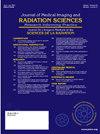Review on early-stage laryngeal cancer soft tissue imaging protocol
IF 2
Q3 RADIOLOGY, NUCLEAR MEDICINE & MEDICAL IMAGING
Journal of Medical Imaging and Radiation Sciences
Pub Date : 2025-07-01
DOI:10.1016/j.jmir.2025.102051
引用次数: 0
Abstract
Aim
Historically, early-stage laryngeal cancer has been treated with lateral opposing fields, centred at thyroid cartilage, with a field size of approximately 6 × 6cm. Since 2017, our centre has adopted the volumetric modulated arc therapy (VMAT) technique, followed by daily cone beam computed tomography (CBCT) for soft tissue matching while adhering to departmental protocol of 0.3cm spinal cord tolerance. Precision of target volume irradiation is crucial to avoid compromising tumour control and overdosing adjacent healthy organs. Due to the concerns about geographical misses from laryngeal motion from swallowing and breathing, we aim to review the critical steps in soft tissue matching for early-stage laryngeal cancer radiotherapy and update our current imaging protocol.
Methods
Fifty-three patients treated with VMAT and daily CBCT imaging were audited. CBCT images of patient re-setups were reviewed and matched manually on MOSIAQ. Bone-based registration covered C3-6 vertebrae while soft tissue-based registration focused on planning target volume (PTV) and thyroid cartilage. Magnitude of shifts (x-, y-, z-directions) were recorded and the variances were calculated. Further observations on the onset and number of re-setups were made.
Results
Thirty-seven out of the 53 patients required re-setups, with the highest being 18 re-setups for a particular patient. A total of 205 repeated CBCTs were analyzed and it was observed that 82% of the re-setups was due to the z-direction [0.64mm ± 0.32 (0.00 - 2.00)], followed by y-direction [0.16mm ± 0.14 (0.00 - 1.00)] and x-direction [0.09mm ± 0.09 (0.00 - 0.40)]. The larger variance in the longitudinal direction is due to the swallowing motion. Majority of re-setups occurred during week 1 and from week 3 onwards. This could be due to patients’ uneasiness or difficulty following instructions at the start of radiotherapy course. Gradual laryngeal shifts contributing to setup errors over the course of radiotherapy are common, often from laryngeal oedema or weight loss.
Conclusion
CBCT has enabled precise soft tissue anatomical-based matching, especially for early-stage laryngeal cancer, because inferior dosimetry has been shown to compromise survival in head and neck cancer patients. Initially, a conservative approach limiting spinal cord variance from target to 0.3cm was to ensure minimal dosimetric impact on spinal cord dose. However, considering the frequency of re-setups and a significant portion of discrepancies exceeding 0.3cm, increasing the allowable tolerance up to 0.5cm is justifiable. This would accommodate anatomical changes, reduce re-setups and maintain clinically acceptable dosimetric outcomes
早期喉癌软组织影像学研究进展
从历史上看,早期喉癌都是通过以甲状腺软骨为中心的侧对野治疗,野大小约为6 × 6cm。自2017年起,本中心采用体积调制弧线治疗(VMAT)技术,每日进行锥形束计算机断层扫描(CBCT)进行软组织匹配,同时坚持科室方案0.3cm脊髓容限。靶体积照射的精确性对于避免影响肿瘤控制和过量照射邻近健康器官至关重要。考虑到吞咽和呼吸引起的喉部运动的地理缺失,我们的目的是回顾早期喉癌放疗中软组织匹配的关键步骤,并更新我们目前的成像方案。方法对53例行VMAT和每日CBCT检查的患者进行回顾性分析。在MOSIAQ上对患者重新设置的CBCT图像进行审查和人工匹配。骨基配准涵盖C3-6椎体,而软组织配准侧重于规划靶体积(PTV)和甲状腺软骨。记录移位幅度(x, y, z方向)并计算方差。对重新设置的开始和次数作了进一步的观察。结果53例患者中有37例需要重新设置,其中某例患者最多需要重新设置18次。共分析205例重复cbct,观察到82%的重新设置是由于z方向[0.64mm±0.32(0.00 - 2.00)],其次是y方向[0.16mm±0.14(0.00 - 1.00)]和x方向[0.09mm±0.09(0.00 - 0.40)]。纵向上较大的变化是由于吞咽运动造成的。大多数重新设置发生在第1周和第3周以后。这可能是由于患者在放疗课程开始时的不安或难以遵循指示。在放疗过程中,逐渐的喉部移位导致设置错误是常见的,通常来自喉部水肿或体重减轻。结论cbct能够实现基于软组织解剖的精确匹配,特别是对于早期喉癌,因为低剂量已被证明会影响头颈癌患者的生存。最初,保守入路将脊髓方差限制在0.3cm以内,以确保对脊髓剂量的剂量学影响最小。然而,考虑到重新设置的频率和很大一部分偏差超过0.3cm,将允许公差增加到0.5cm是合理的。这将适应解剖变化,减少重新设置,并保持临床可接受的剂量学结果
本文章由计算机程序翻译,如有差异,请以英文原文为准。
求助全文
约1分钟内获得全文
求助全文
来源期刊

Journal of Medical Imaging and Radiation Sciences
RADIOLOGY, NUCLEAR MEDICINE & MEDICAL IMAGING-
CiteScore
2.30
自引率
11.10%
发文量
231
审稿时长
53 days
期刊介绍:
Journal of Medical Imaging and Radiation Sciences is the official peer-reviewed journal of the Canadian Association of Medical Radiation Technologists. This journal is published four times a year and is circulated to approximately 11,000 medical radiation technologists, libraries and radiology departments throughout Canada, the United States and overseas. The Journal publishes articles on recent research, new technology and techniques, professional practices, technologists viewpoints as well as relevant book reviews.
 求助内容:
求助内容: 应助结果提醒方式:
应助结果提醒方式:


